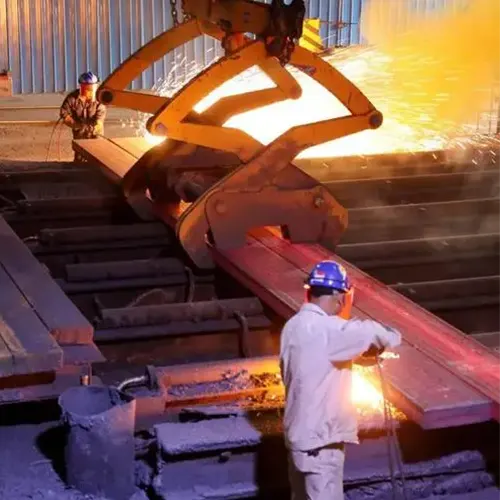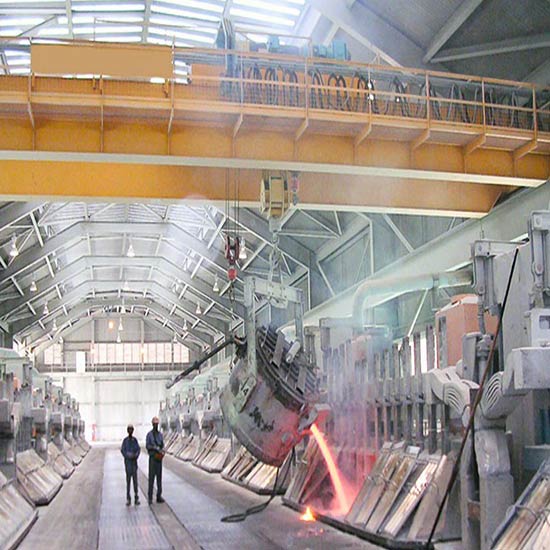Your Trusted Overhead Crane Manufacturer & Supplier
Overhead Crane for Sale Brazil, Custom Bridge Crane & Gantry Crane
Overhead Crane Overview in Brazil: Types, Industrial Applications, Features & Insights
Overhead Crane for sale Brazil. Overview of Overhead Cranes for Sale in Brazilian Market: Types, Industrial Applications, Special Features & Regional Insights.
Overhead Cranes in Brazil: Powering Industry and Innovation
Brazil, a country renowned for its rich cultural diversity and stunning natural landscapes, also boasts a thriving industrial landscape. At the heart of many of Brazil's industrial sectors are overhead cranes, essential machines that play a pivotal role in manufacturing, construction, and various other applications. In this blog, we will delve into the world of overhead cranes in Brazil, exploring their types, their significance in various industries, special features tailored to the Brazilian market, and regional insights that shed light on the dynamic nature of crane usage in this vibrant nation.
Overview of the Overhead Crane Market in Brazil
Brazil's economy has long been fueled by a diverse range of industries, from automotive manufacturing to mining, agriculture, and renewable energy production. This diversity is matched by the array of overhead cranes that power these sectors. Overhead cranes are indispensable tools in the world of heavy lifting and material handling, providing precision and efficiency where manual labor falls short.
The Brazilian market for overhead cranes is robust and dynamic, catering to a wide spectrum of industries with varying needs. These cranes come in various types, each designed to excel in specific applications. From the bustling automotive plants of São Paulo to the towering wind turbines of Ceará's renewable energy sector, overhead cranes are essential components of Brazil's industrial machinery.
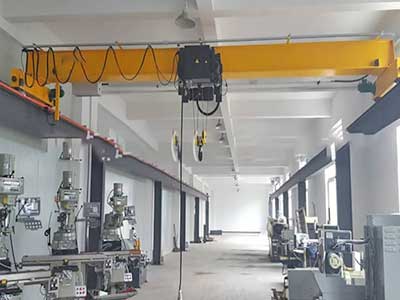
Typical overhead crane type: Bridge Crane
- Crane Capacities: Bridge cranes in Brazil are available in a wide range of capacities, from a few tons to several hundred tons.
- Features: Bridge cranes are versatile and can be customized with various features such as multiple hoists, trolleys, and specialized lifting attachments. They provide efficient horizontal movement within a facility, making them suitable for heavy lifting and precise material handling.
- Industries: Bridge cranes are used across various industries in Brazil, including manufacturing, construction, automotive, steel, and logistics.
- Commonly Used Applications: Bridge cranes are commonly used for tasks such as loading and unloading materials, moving heavy machinery, assembling large components, and transporting goods within a manufacturing or warehouse facility.
- Tailored for the Brazil & typical project locations: Bridge cranes in Brazil are tailored to the specific needs of industries in the region. They are designed to withstand the local environmental conditions and are often used in large manufacturing plants, shipyards, and steel mills. These cranes can be found in cities like São Paulo, Rio de Janeiro, and Porto Alegre, as well as in industrial hubs throughout the country.
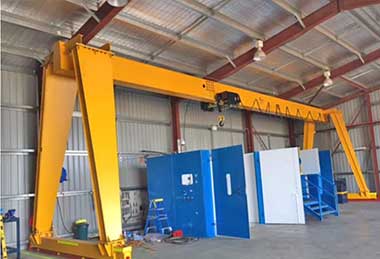
Typical overhead crane type: Gantry Crane
- Crane Capacities: Gantry cranes available in Brazil come in a range of capacities, suitable for both indoor and outdoor applications.
- Features: Gantry cranes are known for their mobility and stability. They can be easily moved around a facility or construction site, and their design allows for lifting and moving heavy loads in a flexible manner.
- Industries: Gantry cranes find applications in various industries in Brazil, including shipbuilding, construction, mining, and container handling at ports.
- Commonly Used Applications: Gantry cranes are often used for loading and unloading cargo from ships, handling construction materials on-site, and assisting in large-scale infrastructure projects.
- Tailored for the Brazil & typical project locations: Gantry cranes in Brazil are adapted to withstand the country's weather conditions, especially in coastal areas with high humidity. They are commonly seen in ports like Santos and Rio de Janeiro, as well as in construction projects in major cities like Brasília and Belo Horizonte.
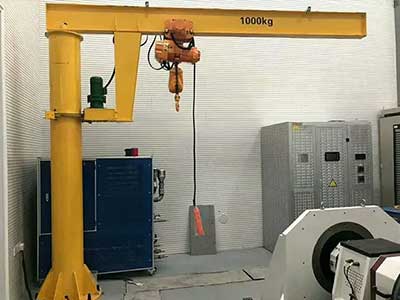
Typical overhead crane type: Jib Crane
- Crane Capacities: Jib cranes in Brazil typically come in capacities ranging from a few hundred kilograms to a few tons.
- Features: Jib cranes are characterized by their vertical mast with a horizontal jib arm. They offer 360-degree rotation, making them ideal for localized lifting and precise positioning of loads.
- Industries: Jib cranes are used in a wide range of industries in Brazil, including manufacturing, workshops, warehouses, and small to medium-sized enterprises.
- Commonly Used Applications: Jib cranes are commonly used for tasks such as assembly line workstations, loading and unloading materials, and handling heavy components in workshops.
- Tailored for the Brazil & typical project locations: Jib cranes are often tailored to the specific needs of Brazilian industries. They are commonly found in industrial districts in cities like Curitiba, Campinas, and Manaus, where manufacturing and assembly operations are prevalent.
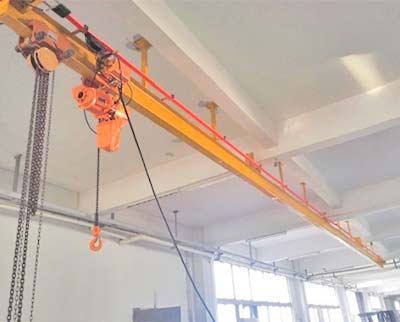
Typical overhead crane type: Monorail Crane
- Crane Capacities: Monorail cranes in Brazil are available in various capacities, ranging from light-duty to heavy-duty applications.
- Features: Monorail cranes consist of a single rail or beam and are designed for moving materials along a fixed path within a facility. They are space-efficient and suitable for linear material handling.
- Industries: Monorail cranes find applications in industries such as automotive manufacturing, food processing, and warehousing in Brazil.
- Commonly Used Applications: Monorail cranes are commonly used for transporting materials along a production line, moving goods between workstations, and facilitating efficient material flow in manufacturing processes.
- Tailored for the Brazil & typical project locations: Monorail cranes in Brazil are customized to meet the specific requirements of industries, ensuring they are robust and reliable. They are often used in industrial clusters in cities like São Paulo, Campinas, and Porto Alegre.
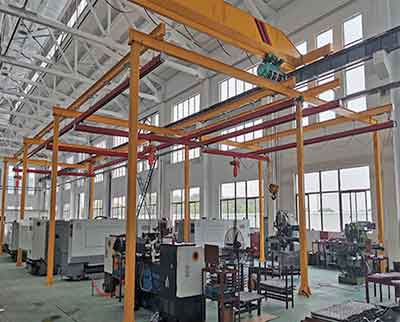
Typical overhead crane type: Workstation Crane
- Crane Capacities: Workstation cranes in Brazil come in various capacities, typically ranging from light-duty to medium-duty applications.
- Features: Workstation cranes are designed for localized material handling within a specific work area. They are often installed above individual workstations or assembly areas and provide ergonomic and efficient lifting solutions.
- Industries: Workstation cranes are used in industries such as manufacturing, assembly, and maintenance, where precision handling and ergonomics are important.
- Commonly Used Applications: Workstation cranes are commonly used for tasks such as moving materials and components within a workstation, aiding in assembly processes, and facilitating efficient work in small to medium-sized manufacturing operations.
- Tailored for the Brazil & typical project locations: Workstation cranes are tailored to meet the specific needs of Brazilian industries, especially in manufacturing facilities and workshops across the country.
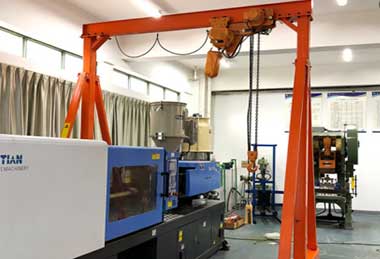
Typical overhead crane type: Portable Gantry Crane
- Crane Capacities: Portable gantry cranes in Brazil come in various capacities, typically ranging from a few hundred kilograms to several tons.
- Features: Portable gantry cranes are designed for mobility and versatility. They consist of a horizontal beam supported by uprights or A-frame legs with wheels, allowing them to be easily moved to different locations within a facility. They are a cost-effective solution for lifting and transporting heavy loads.
- Industries: Portable gantry cranes find applications in a wide range of industries in Brazil, including construction, workshops, maintenance, and manufacturing.
- Commonly Used Applications: Portable gantry cranes are commonly used for tasks such as lifting and moving machinery, equipment, and materials in workshops, warehouses, and outdoor construction sites. They are particularly valuable in settings where a permanent overhead crane installation may not be practical.
- Tailored for the Brazil & typical project locations: Portable gantry cranes are designed to meet the mobility needs of Brazilian industries. They are often used in construction projects across the country, including in cities like São Paulo, Rio de Janeiro, and Brasília. These cranes are also found in maintenance facilities, workshops, and small to medium-sized manufacturing operations.
- Portable gantry cranes offer a flexible solution for temporary lifting and material handling needs, making them a popular choice in Brazil's diverse industrial landscape.
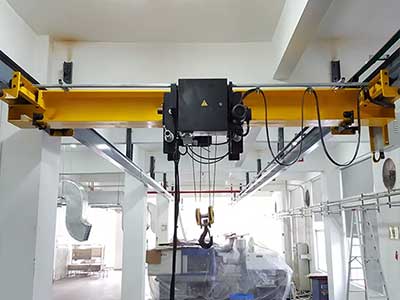
Typical overhead crane type: Underhung Crane
- Crane Capacities: Underhung cranes in Brazil come in various capacities, ranging from light-duty to heavy-duty applications.
- Features: Underhung cranes, also known as under-running cranes, are designed to run on tracks attached to the ceiling of a facility. They are known for their space-saving design and are used when there is limited overhead clearance. Underhung cranes are often used for precision material handling and assembly tasks.
- Industries: Underhung cranes are used in industries such as manufacturing, aerospace, and automotive, where precision and limited space are critical.
- Commonly Used Applications: Underhung cranes are commonly used for tasks that require precise positioning and control, such as moving components along assembly lines and transporting materials within manufacturing cells.
- Tailored for the Brazil & typical project locations: Underhung cranes are customized to meet the specific needs of Brazilian industries, especially in manufacturing clusters in cities like São Paulo, Curitiba, and Campinas.

Typical overhead crane type: Freestanding Crane
- Crane Capacities: Freestanding cranes in Brazil come in various capacities, depending on the specific requirements of the project or facility.
- Features: Freestanding cranes, also known as standalone or self-supporting cranes, do not rely on existing support structures. They are designed to be placed anywhere within a facility and are often used when traditional overhead runways or support structures are not available.
- Industries: Freestanding cranes are versatile and can be used in various industries, including manufacturing, steel, construction, and maintenance.
- Commonly Used Applications: Freestanding cranes are used for lifting and moving heavy loads in areas where traditional overhead cranes cannot be installed. They are suitable for tasks such as loading and unloading materials, handling large equipment, and supporting construction projects.
- Tailored for the Brazil & typical project locations: Freestanding cranes can be customized to meet the specific needs of Brazilian industries and are often used in construction projects, manufacturing facilities, and warehouses throughout the country.
Industrial Sectors and Crane Usage
Overhead cranes are used in various industrial sectors in Brazil for material handling, and the specific types of overhead cranes used can vary depending on the sector and its requirements. Here's a general overview of the types of industrial overhead cranes commonly used in some of the key industrial sectors mentioned earlier:
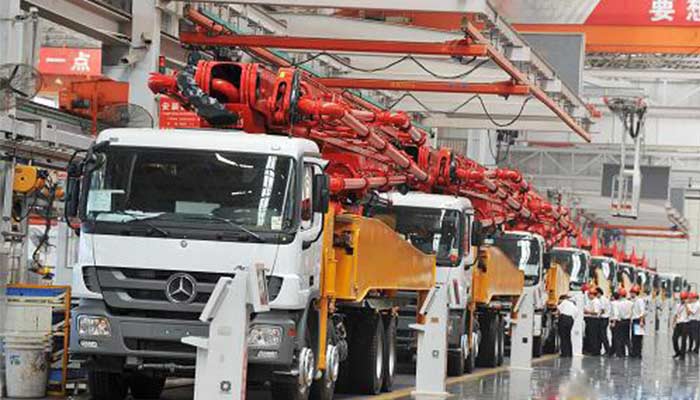
Automotive Industry: Building Brazil's Wheels of Progress
Brazil's automotive industry relies heavily on overhead cranes to streamline production processes. These cranes play a critical role in moving heavy automotive components, such as chassis, engines, and body parts, efficiently along assembly lines. They ensure precise positioning and sequencing, contributing to the timely production of vehicles.
- - Industrial Overview: Brazil's automotive industry is well-established and includes domestic production as well as assembly plants of major international car manufacturers. The sector produces a wide range of vehicles, from small cars to trucks and buses.
- - Typical City Location: São Paulo, Curitiba, and Betim.
- - Types of Overhead Cranes Used: Bridge Cranes, Jib Cranes. - Bridge Cranes: Bridge cranes are used for moving heavy automotive components and machinery within manufacturing plants. - Jib Cranes: Jib cranes may be used at specific workstations for assembly and material handling.
- - Typical Crane Capacity: Varied, depending on specific applications.
- - Typical Functions and Applications: Overhead cranes are used for moving heavy automotive components, machinery, and vehicle parts within manufacturing plants. Jib cranes are often used at specific workstations for assembly and material handling.
- - Benefits: Overhead cranes improve efficiency in the assembly and production process, reducing manual labor and increasing safety.
- Specific crane requirements in automotive plants: In automotive plants, bridge cranes with varying lifting capacities are commonly used. Precision and speed are key, making overhead cranes indispensable in maintaining the high production standards of the Brazilian automotive industry.
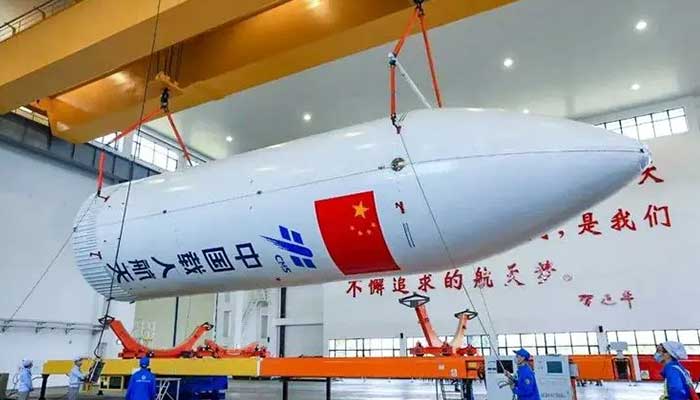
Aerospace and Aviation: Reaching New Heights
Use of overhead cranes in aircraft manufacturing and maintenance
Brazil's aerospace and aviation sector, led by companies like Embraer, demands precision and safety in every step. Overhead cranes are employed in the handling of delicate aircraft components during assembly, maintenance, and repairs. They ensure that aircraft are built and maintained to the highest standards of quality.
- - Industrial Overview: Brazil has a growing aerospace and aviation industry, with a focus on aircraft manufacturing, components production, and defense systems. Embraer, a prominent aircraft manufacturer, is headquartered in Brazil.
- - Typical City Location: São José dos Campos, São Paulo.
- - Types of Overhead Cranes Used: Bridge Cranes, Gantry Cranes.
- - Bridge Cranes: Large bridge cranes are used for handling aircraft components during assembly.
- - Gantry Cranes: Gantry cranes are utilized for moving aircraft parts in hangars and maintenance facilities.
- - Typical Crane Capacity: Varied, depending on specific aircraft components.In this sector, gantry cranes and bridge cranes with varying capacities are utilized. The crane's ability to handle sensitive aerospace components with care and precision is paramount in ensuring the reliability and safety of aircraft.
- - Typical Functions and Applications: Overhead cranes are used for handling aircraft components during assembly and manufacturing processes. Gantry cranes assist in moving large aircraft parts in hangars and maintenance facilities.
- - Benefits: Overhead cranes ensure precise handling of critical aerospace components, contributing to the quality and safety of aircraft production.
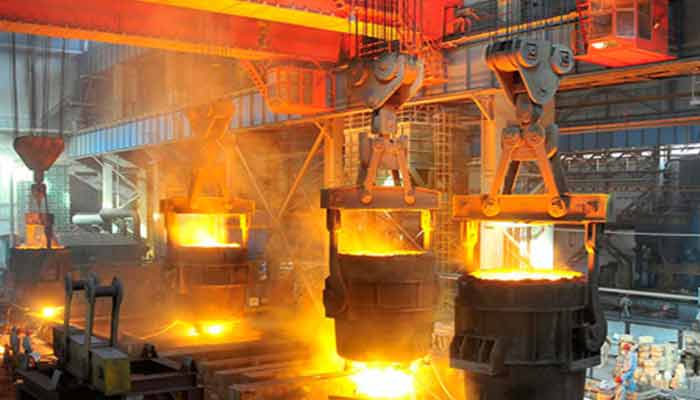
Steel and Metalworking: Shaping the Foundations of Brazil
How are overhead cranes utilized in steel production and metalworking facilities?
The steel industry is a core part of Brazil's industrial landscape. Overhead cranes are essential for handling heavy steel beams, sheets, and machinery within steel mills and metalworking facilities. These cranes facilitate material flow and the manufacturing of a wide range of steel products.
- - Industrial Overview: Brazil's steel industry is vital, producing steel products for construction, automotive, and infrastructure development.
- - Typical City Location: São Paulo, Rio de Janeiro, Minas Gerais.
- - Types of Overhead Cranes Used: Bridge Cranes, Gantry Cranes.
- - Bridge Cranes: Bridge cranes are vital for moving heavy steel materials within steel mills and metalworking facilities.
- - Gantry Cranes: Gantry cranes are used for handling large steel beams and sheets.
- - Typical Crane Capacity: High capacity to handle heavy steel materials. In steel and metalworking, gantry cranes and bridge cranes with high lifting capacities are the norm. The ability to handle massive loads with precision is crucial for the efficiency and safety of operations.
- - Typical Functions and Applications: Overhead cranes are used for transporting heavy steel beams, sheets, and machinery within steel mills and metalworking facilities.
- - Benefits: Overhead cranes enhance material handling efficiency and safety in steel manufacturing, supporting the production of a wide range of steel products.
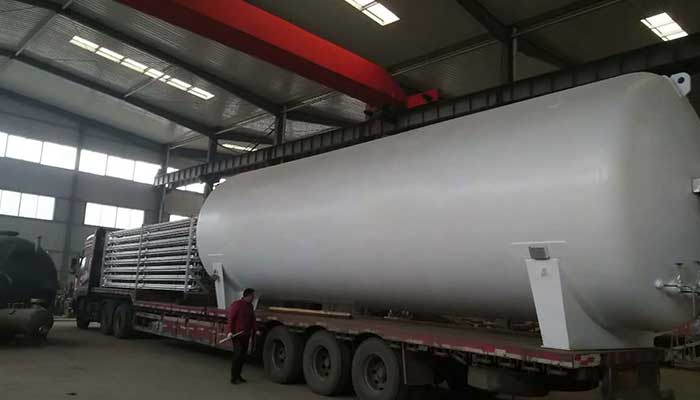
Oil and Gas: Navigating Challenging Terrains
Importance of overhead cranes in offshore and onshore oil and gas operations
Brazil's extensive offshore oil reserves have positioned it as a major player in the global oil and gas industry. Offshore platforms, refineries, and exploration sites rely on overhead cranes for lifting and moving equipment in challenging environments. These cranes ensure the safe and efficient operation of Brazil's oil and gas sector.
- - Industrial Overview: Brazil is a significant player in the oil and gas industry, involved in exploration, production, refining, and equipment manufacturing.
- - Typical City Location: Rio de Janeiro, Santos, Macaé.
- - Types of Overhead Cranes Used: Bridge Cranes, Gantry Cranes.
- - Bridge Cranes: Bridge cranes are employed in offshore oil platforms for lifting and moving equipment.
- - Gantry Cranes: Gantry cranes may be used in oil refineries for maintenance and material handling.
- - Typical Crane Capacity: High capacity for offshore and onshore applications.
- - Typical Functions and Applications: Overhead cranes are used in offshore oil platforms for lifting and moving equipment. Gantry cranes assist in material handling and maintenance in oil refineries.
- - Benefits: Overhead cranes ensure the safe and efficient handling of heavy equipment in challenging offshore and onshore oil and gas environments.
- Compliance with safety standards in the oil and gas sector:Safety standards and compliance with stringent regulations are non-negotiable in the oil and gas sector. Overhead cranes used in this industry are designed and maintained to meet these high safety standards, ensuring the protection of both personnel and assets.
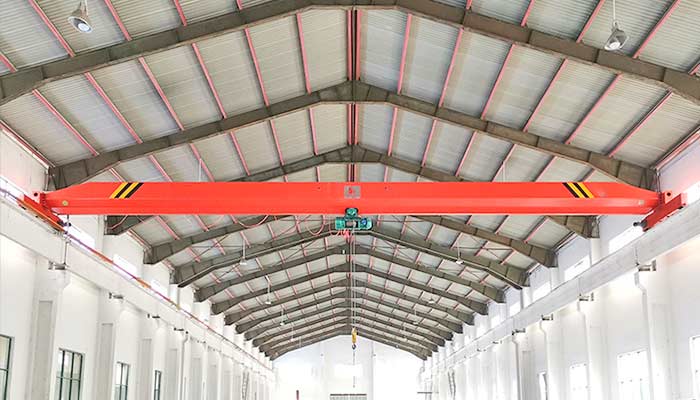
Chemicals and Petrochemicals: Handling Hazardous Materials with Care
Crane applications in chemical and petrochemical plants
Brazil's chemicals and petrochemicals industry produces a wide range of products, including hazardous materials. Overhead cranes play a crucial role in safely handling and transporting these materials within plants. They are instrumental in ensuring the precise placement of heavy chemical containers and equipment.
- - Industrial Overview: Brazil's chemicals and petrochemicals industry produces a wide range of chemical products, including plastics, fertilizers, and pharmaceuticals.
- - Typical City Location: São Paulo, Bahia, Rio de Janeiro.
- - Types of Overhead Cranes Used: Bridge Cranes, Jib Cranes.
- - Bridge Cranes: Bridge cranes are used for maintenance and material handling in chemical and petrochemical plants.
- - Jib Cranes: Jib cranes can be found in laboratories and facilities for handling chemical containers.
- - Typical Crane Capacity: Varied, depending on specific chemical handling requirements.
- - Typical Functions and Applications: Overhead cranes are used for maintenance and material handling in chemical and petrochemical plants. Jib cranes assist in handling chemical containers and equipment.
- - Benefits: Overhead cranes improve safety and efficiency in the handling of chemical products, ensuring precise placement and reducing the risk of accidents.
- Considerations for handling hazardous materials:When it comes to hazardous materials, specialized crane features, such as explosion-proof components and anti-corrosion coatings, are essential. Overhead cranes used in chemical and petrochemical plants are customized to meet these specific requirements.
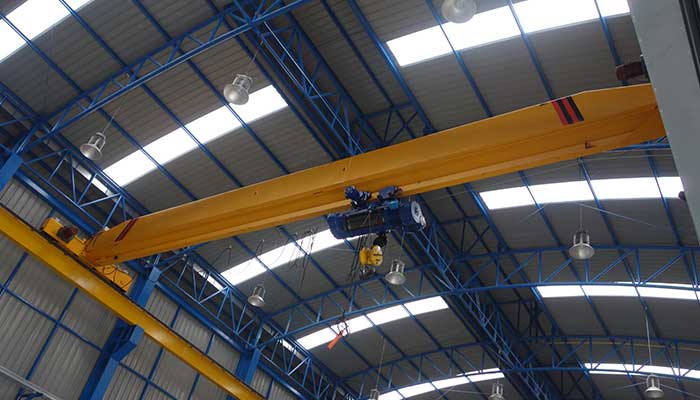
Agribusiness: Feeding the World
Brazil is a global leader in agribusiness, and efficient material handling is critical in this sector. Overhead cranes are used in grain storage facilities and for moving heavy agricultural machinery. They contribute to the smooth flow of grains and ensure the maintenance of essential farming equipment.
- - Industrial Overview: Brazil is a global leader in agribusiness, with a robust agricultural and food processing sector, exporting agricultural products such as soybeans, beef, poultry, and coffee.
- - Typical City Location: São Paulo, Mato Grosso, Paraná.
- - Types of Overhead Cranes Used: Bridge Cranes, Gantry Cranes.
- - Bridge Cranes: Bridge cranes are used in agribusiness for lifting and moving heavy agricultural machinery.
- - Gantry Cranes: Gantry cranes may be used for material handling in grain storage and processing facilities.
- - Typical Crane Capacity: Varied, depending on specific agricultural processing needs.
- - Typical Functions and Applications: Overhead cranes are used for material handling in grain storage and processing facilities, as well as for moving heavy agricultural machinery.
- - Benefits: Overhead cranes streamline the handling of agricultural products, improving efficiency in grain processing and machinery maintenance.
- Customizations for agribusiness facilities:In agribusiness, gantry cranes and bridge cranes are often customized to handle specific agricultural products and equipment. They are designed to withstand the challenges of handling grains and the rigors of outdoor agricultural settings.
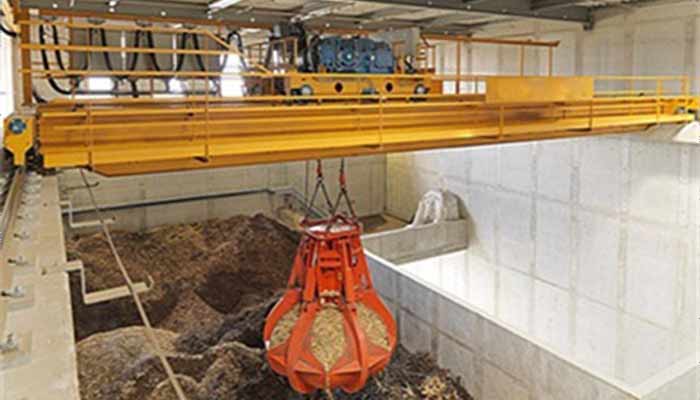
- - Industrial Overview: Brazil has a growing renewable energy sector, including ethanol production from sugarcane and wind energy, positioning the country as a global leader in biofuels production.
- - Typical City Location: São Paulo, Rio Grande do Sul, Ceará.
- - Types of Overhead Cranes Used: Bridge Cranes, Gantry Cranes.
- - Bridge Cranes: Bridge cranes are utilized in wind turbine manufacturing facilities for assembling wind turbine components.
- - Gantry Cranes: Gantry cranes can be used in biomass and biofuel production facilities for material handling.
- - Typical Crane Capacity: Varied, depending on specific renewable energy components.
- - Typical Functions and Applications: Overhead cranes are used in the assembly of wind turbines and handling of biofuel production equipment.
- - Benefits: Overhead cranes ensure the safe and precise assembly of renewable energy components, contributing to the expansion of Brazil's green energy sector.
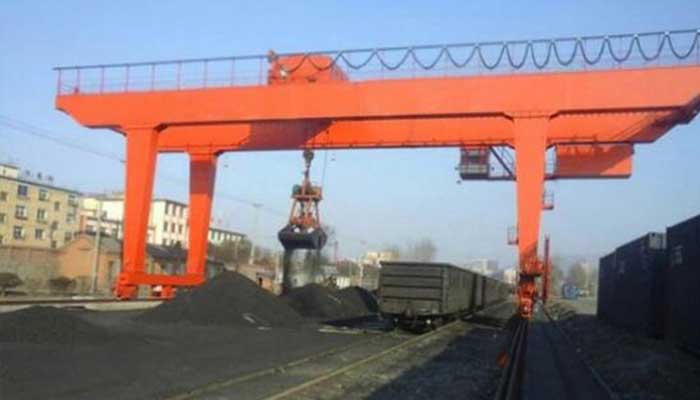
- - Industrial Overview: Brazil is rich in mineral resources and is a major producer of iron ore, bauxite, gold, and other minerals.
- - Typical City Location: Minas Gerais, Pará, Bahia.
- - Types of Overhead Cranes Used: Bridge Cranes, Gantry Cranes.
- - Bridge Cranes: Bridge cranes are employed in mining operations for transporting heavy minerals and equipment.
- - Gantry Cranes: Gantry cranes may be used in mining facilities for handling large ore containers.
- - Typical Crane Capacity: High capacity for handling heavy minerals and equipment.
- - Typical Functions and Applications: Overhead cranes are used in mining operations for transporting heavy minerals and equipment within mines and processing plants.
- - Benefits: Overhead cranes facilitate the efficient and safe movement of minerals, contributing to the mining industry's productivity and safety.
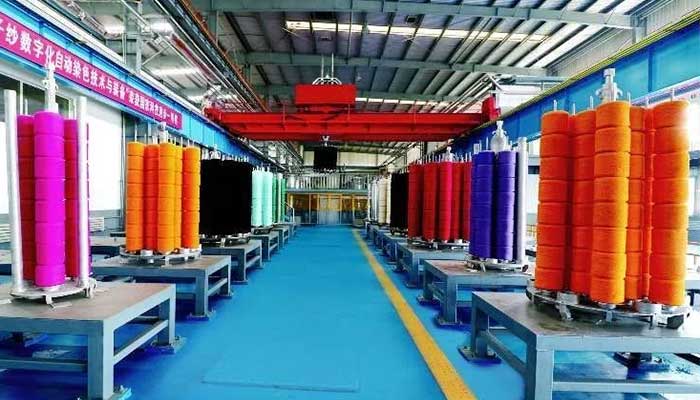
- - Industrial Overview: Brazil's textile and apparel industry manufactures clothing and textile products for both domestic consumption and export.
- - Typical City Location: São Paulo, Santa Catarina, Pernambuco.
- - Types of Overhead Cranes Used: Bridge Cranes, Jib Cranes.
- - Bridge Cranes: Bridge cranes may be used for handling textile rolls and machinery in textile factories.
- - Typical Crane Capacity: Varied, depending on specific textile and apparel handling requirements.
- - Typical Functions and Applications: Overhead cranes are used for material handling, including the movement of textile rolls and machinery in textile factories.
- - Benefits: Overhead cranes improve efficiency in the handling of textiles and apparel materials, aiding in the production process.
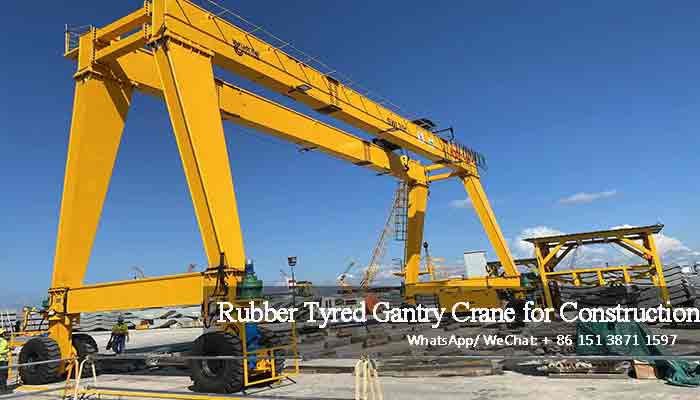
Construction and Infrastructure:
- - Industrial Overview: Brazil has ongoing infrastructure development and construction projects, making the construction sector a significant contributor to the economy.
- - Typical City Location: Major cities nationwide, including São Paulo, Rio de Janeiro, and Brasília.
- - Types of Overhead Cranes Used: Gantry Cranes, Tower Cranes (for vertical material handling).
- - Gantry Cranes: Gantry cranes are commonly used in construction sites for lifting and positioning heavy construction materials.
- - Tower Cranes: While not overhead cranes, tower cranes are frequently used in construction projects for vertical material handling.
- - Typical Crane Capacity: Varied, depending on specific construction needs.
- - Typical Functions and Applications: Overhead cranes are used in construction sites for lifting and positioning heavy
- construction materials. Tower cranes are often used for vertical material handling.
- - Benefits: Overhead cranes enhance efficiency and safety in construction projects, allowing for the precise placement of heavy materials.
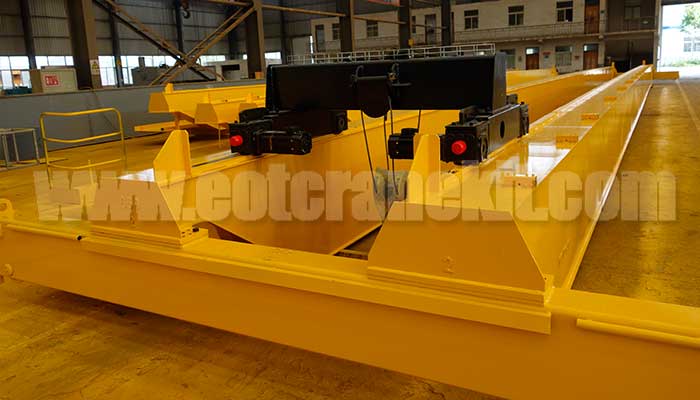
Electronics and Information Technology:
- - Industrial Overview: Brazil has a growing electronics and IT industry, producing consumer electronics, software, and telecommunications equipment.
- - Typical City Location: São Paulo, Campinas, Manaus.
- - Types of Overhead Cranes Used: Jib Cranes.
- - Jib Cranes: Jib cranes can be used for precision material handling in electronics manufacturing and assembly.
- - Typical Crane Capacity: Varied, depending on specific electronic component handling requirements.
- - Typical Functions and Applications: Jib cranes are used for precision material handling in electronics manufacturing and assembly.
- - Benefits: Jib cranes facilitate precise and ergonomic handling of electronic components, improving production efficiency and product quality.
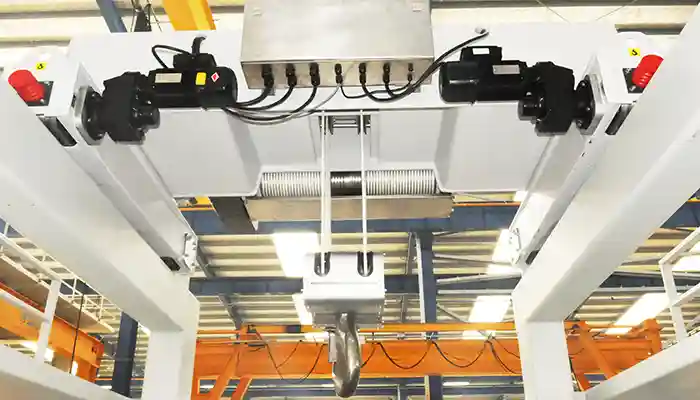
- - Industrial Overview: The food and beverage industry includes the production of various food products, beverages, and processed foods for domestic consumption and export.
- - Typical City Location: São Paulo, Minas Gerais, Rio Grande do Sul.
- - Types of Overhead Cranes Used: Bridge Cranes.
- - Bridge Cranes: Bridge cranes are used for material handling in food processing and packaging plants.
- - Typical Crane Capacity: Varied, depending on specific food and beverage handling requirements.
- - Typical Functions and Applications: Overhead cranes are used for material handling within food processing and packaging plants.
- - Benefits: Overhead cranes streamline the handling of food products, ensuring efficiency and adherence to food safety standards.
The choice of overhead crane type and capacity within each sector depends on factors such as the weight of materials to be handled, the layout of the facility, and specific operational requirements. It's important to note that while these are common types of overhead cranes used in various sectors, there can be variations and customizations based on the unique needs of each industry and individual facilities in Brazil.
Industrial Hotspots in Brazil
As we conclude our journey through the world of overhead cranes in Brazil, let's explore the industrial hotspots in this vibrant nation and summarize the significance of these cranes in Brazilian industries.
Key Cities and Regions: Where Industries Thrive
Brazil's industrial landscape is as diverse as its geography. Key cities and regions serve as epicenters for specific industries, and overhead cranes are an integral part of their success.
- - São Paulo: Brazil's economic powerhouse, São Paulo, is a hub for the automotive, aerospace, and electronics industries. Overhead cranes in this region support the high production demands of these sectors.
- - Minas Gerais: Known for its abundant mineral resources, Minas Gerais relies on overhead cranes in its mining and steel industries. Cranes play a vital role in the extraction and processing of minerals.
- - Rio de Janeiro: With its prominent role in the oil and gas sector, Rio de Janeiro's offshore platforms and refineries heavily depend on overhead cranes. These cranes ensure the safe handling of equipment in challenging offshore environments.
- - Bahia: The renewable energy sector, particularly wind energy, has a strong presence in Bahia. Overhead cranes are instrumental in assembling wind turbines, making this region a hotbed of crane activity.
- - Santa Catarina: The textile and apparel industry in Santa Catarina relies on overhead cranes for efficient material handling. Cranes help in the production of textiles and clothing, a significant sector in the region.
Tailored Crane Solutions: Meeting Regional Needs
Brazil's vast industrial diversity demands tailored crane solutions. Manufacturers and suppliers of overhead cranes understand the unique requirements of each region and industry. Whether it's designing cranes for heavy metal handling in Minas Gerais or precision handling in São Paulo's electronics sector, customization is key. These solutions ensure that overhead cranes effectively meet the demands of specific industrial clusters.
Special Features for the Brazilian Market
In the ever-changing Brazilian environment, overhead cranes must adapt to meet unique challenges and comply with stringent regulations. Let's explore the special features tailored to the Brazilian market that ensure safe and efficient crane operations.
Climate and Weather Considerations: Battling the Elements
How do weather conditions in Brazil influence crane design and materials? Brazil's vast geographical diversity means that overhead cranes operate in a range of climates, from the humid Amazon rainforest to the arid northeastern deserts. To withstand these conditions, crane designs and materials must be carefully chosen. Corrosion-resistant materials and weatherproof coatings are common features to protect against rust and deterioration caused by Brazil's humidity and occasional heavy rainfall.
Corrosion resistance and weatherproofing features
Overhead cranes designed for the Brazilian market are often equipped with corrosion-resistant coatings, galvanized components, and sealed electrical systems. These features not only extend the crane's lifespan but also ensure reliable performance even in challenging weather conditions.
National Regulations: Complying with Stringent Standards
Brazil has strict regulations governing the electrical and safety standards for overhead cranes. These regulations are designed to ensure the safety of operators, workers, and the public. Overhead crane manufacturers and operators must adhere to these standards to operate legally in Brazil.
Certification and compliance requirements
Overhead cranes must undergo rigorous testing and certification processes to ensure compliance with Brazilian standards. Certifications and inspections are conducted by authorized bodies to verify that cranes meet safety and performance criteria. Compliance is critical to prevent accidents and maintain the integrity of industrial operations.
Maintenance and Inspection: Safeguarding Reliability
Importance of regular maintenance and inspection in varying environmental conditions -Regular maintenance and inspection of overhead cranes are paramount in Brazil's diverse climate. The humid, tropical conditions can accelerate wear and tear on crane components. Routine maintenance, including lubrication, component replacement, and structural inspections, ensures that cranes operate smoothly and safely.
Crane maintenance schedules and safety protocols in Brazil -Brazilian facilities often follow strict maintenance schedules and safety protocols. Maintenance personnel are trained to detect and address issues promptly. Additionally, safety protocols are in place to protect workers during crane maintenance activities, as safety is a top priority in Brazilian industries.
Training and Certification: Empowering Crane Operators
Crane operator training and certification requirements in Brazil -Crane operators in Brazil are required to undergo specialized training and obtain certifications. Training programs cover crane operation techniques, safety procedures, and compliance with regulations. Certified operators are crucial for safe crane operation and the prevention of accidents.
Ensuring safe crane operation in compliance with local standards -Operators are responsible for following local safety standards and regulations while operating overhead cranes. They must also be aware of the specific features and limitations of the cranes they operate to ensure the safety of themselves and those around them.
In Brazil, special attention is paid to creating an environment where overhead cranes can operate reliably and safely, regardless of the climate or weather conditions. The combination of stringent regulations, regular maintenance, and well-trained operators ensures that overhead cranes play a vital role in the success of Brazilian industries while maintaining the highest safety standards. In our next segment, we'll explore the industrial hotspots in Brazil, shedding light on key cities and regions where specific industries and crane installations are prevalent.
Conclusion
In conclusion, overhead cranes are the unsung heroes of Brazil's industrial landscape. They are the sturdy workhorses that lift and move the materials and equipment that power the nation's diverse sectors, from manufacturing and mining to aerospace and renewable energy. Overhead cranes are not merely machines; they are the backbone of efficiency, safety, and productivity in Brazilian industries.
The importance of overhead cranes in Brazil cannot be overstated. They enable the production of automobiles that traverse the nation's highways, the construction of soaring skyscrapers that dot its urban landscapes, and the harnessing of renewable energy from its wind-swept plains. These cranes are more than just tools; they are the enablers of progress and innovation.
Overhead crane suppliers and manufacturers play a pivotal role in ensuring that these machines are tailored to the diverse needs of the Brazilian market. They understand the nuances of Brazil's climate, regulatory environment, and industrial demands, delivering cranes that meet and exceed expectations.
As Brazil continues to grow and evolve on the global stage, overhead cranes will remain indispensable, supporting the nation's journey towards economic prosperity and technological advancement. With safety as a top priority and innovation as a guiding principle, overhead cranes are set to continue lifting Brazil to new heights.
